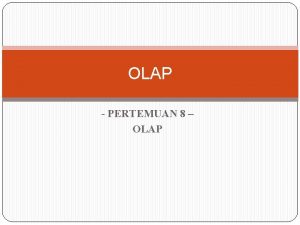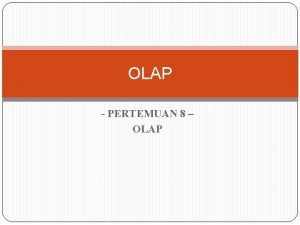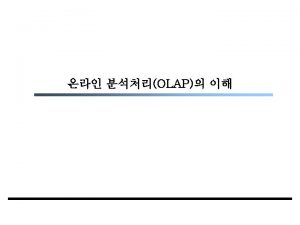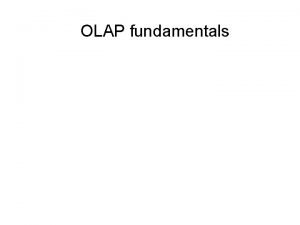OLAP Think of an OLAP data structure as





- Slides: 5

OLAP "Think of an OLAP data structure as a Rubik's Cube of data that users can twist and twirl in different ways to work through what-if and whathappened scenarios. " - Lee The, Editor, Datamation (May 1995)

Typical information that a decision support application gather and presents • Comparative sales figures between one week and the next • Projected revenue figures based on new product sales assumptions • The consequences of different decision alternatives, given past experience in a context

Multi dimensional data • Data that can be modeled as dimension attribute and measure attributes are called multi dimensional data e. g. , given a purchase relation, the number of units bought is the measure attribute. Dimension attribute define the dimensions, on which measure attributes & summarises of measure attributes, are viewed

Business Intelligence Tools Software that enables business users to see and use large amounts of complex data. The following three types of tools are referred to as Business Intelligence Tools: Multi-Dimensional Analysis Software - Also Known As Multi Software or OLAP (On-Line Analytical Processing) Software that gives the user the opportunity to look at the data from a variety of different dimensions. Query Tools - Software that allows the user to ask questions about patterns or details in the data. Data Mining Tools - Software that automatically searches for significant patterns or correlations in the data.

Data Mining The process of finding hidden patterns and relationships in the data. Analyzing data aid in the recognition of significant patterns. Human analysts can see patterns in small data sets. Specialized data mining tools are able to find patterns in large amounts of data. Users can ask questions using standard queries when they know what they're looking for. Queries can be written for questions like this: "Which of our new customers have given us the most business in the last 6 months? " Data mining is needed when the user's questions are more vague or general in nature. Data mining questions would include: "What attributes characterize the customers that gave us the most business in the past 6 months? "









